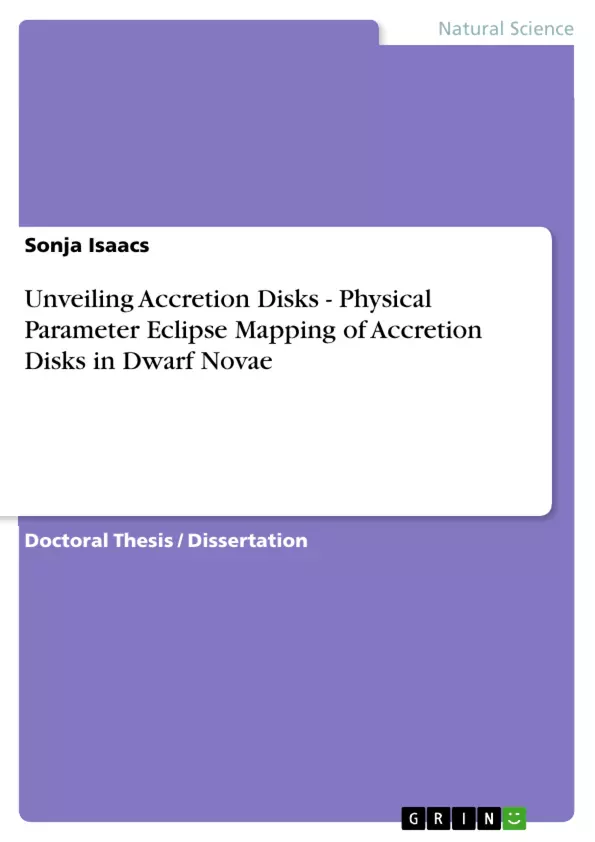Diese Arbeit stellt eine neue Tomographiemethode vor, die Bedeckungstomographie in physikalischen Parametern (
Physical Parameter Eclipse Mapping
). Sie ist entwickelt um die Struktur von Akkretionsscheiben in kataklysmischen Veränderlichen direkt in Form der grundlegenden physikalischen Parameter zu kartieren.
Kataklysmische Veränderliche sind enge Doppelsternsysteme, in denen Materietransfer von einem der Sterne, typischerweise ein Hauptreihenstern, zum anderen einem weißen Zwerg, stattfindet und zu der Ausbildung einer Akkretionsscheibe führt. Akkretionsscheiben sind von generellem Interesse in der Astrophysik, da sie in einer Vielzahl von Objekten mit Masseneinfall auftreten, wie z.B. aktiven
galaktischen Kernen und jungen stellaren Objekten. Bedeckende kataklysmische Veränderliche sind ideale Laboratorien um solche Akkretionsprozesse zu untersuchen da mit Veränderung der Bahnphase unterschiedliche Teile der Scheibe sichtbar werden.
[...]
Inhaltsverzeichnis (Table of Contents)
- Preface
- Accretion in Cataclysmic Variables
- Cataclysmic Variables
- The observations
- The accretion disk
- The white dwarf
- The boundary layer
- The bright spot and the gas stream
- The red star
- The outburst state
- Theories of accretion phenomena
- The viscosity
- The outbursts
- The Disk Instability model
- The Mass Transfer Burst model
- DI model vs. MTB model
- IP Peg and HT Cas
- The \"puzzling\" system IP Pegasi
- A Dwarf Nova in the spotlight
- The spectral appearance
- The primary component
- The secondary component: The red star
- Setting the scene
- The eclipses
- Summary of the disk parameters
- The \"Rosetta Stone\" HT Cassiopeiae
- An unusual Dwarf Nova
- The spectral appearance
- The primary component
- The secondary component: The red star
- Setting the scene
- The eclipses
- Summary of the disk parameters
- The \"puzzling\" system IP Pegasi
Zielsetzung und Themenschwerpunkte (Objectives and Key Themes)
This dissertation focuses on developing and applying a new tomography method, Physical Parameter Eclipse Mapping, to reconstruct the structure of accretion disks in cataclysmic variables. The aim is to directly map the disk's structure in terms of fundamental physical parameters like temperature and surface density.
- Physical Parameter Eclipse Mapping: A new tomography method for reconstructing accretion disk structure.
- Accretion disks in cataclysmic variables: Their structure, physical properties, and importance in astrophysics.
- Applications of the method to real data: Analyzing the dwarf novae IP Pegasi and HT Cassiopeiae.
- Comparison of results with classical Eclipse Mapping: Examining differences in intensity distributions and physical parameters.
- Contribution to understanding accretion processes: Gaining insights into the dynamics and evolution of accretion disks.
Zusammenfassung der Kapitel (Chapter Summaries)
The dissertation begins with an introduction to accretion disks in cataclysmic variables, covering their structure, physical properties, and the importance of studying these systems. It then dives into the development of the new Physical Parameter Eclipse Mapping method, outlining its theoretical foundation and demonstrating its capabilities through synthetic data analysis. The subsequent chapters explore the application of the method to real data from two dwarf novae, IP Pegasi and HT Cassiopeiae, focusing on their unique characteristics, spectral properties, and the results of the tomography analysis. The comparison of these results with classical Eclipse Mapping reveals important insights into the physical processes occurring in accretion disks.
Schlüsselwörter (Keywords)
The key words and focus topics of this dissertation revolve around accretion disks in cataclysmic variables, their structure, and the application of Physical Parameter Eclipse Mapping. The work delves into topics such as physical parameters like temperature and surface density, the analysis of real data from dwarf novae IP Pegasi and HT Cassiopeiae, and the comparison between the new tomography method and classical Eclipse Mapping. These themes contribute to understanding the dynamics and evolution of accretion processes in these systems, furthering our knowledge in astrophysics.
- Citar trabajo
- Sonja Isaacs (Autor), 1997, Unveiling Accretion Disks - Physical Parameter Eclipse Mapping of Accretion Disks in Dwarf Novae, Múnich, GRIN Verlag, https://www.grin.com/document/2964



